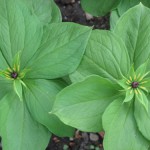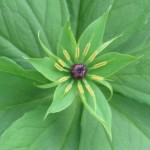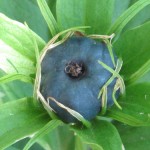Posts Tagged ‘Geoffrey Grigson’
Friday, June 17, 2011
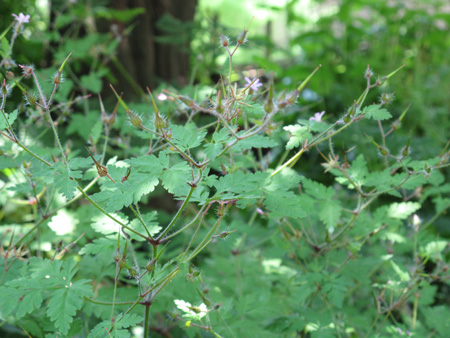
Herb Robert (Geranium robertianum), called ruprechtskraut in German, is sometimes said to derive its name from the seventh-century Saint Rupert or Robert of Salzburg, but the plant is also associated with the German hobgoblin Knecht Ruprecht and his English counterpart, Robin Goodfellow.
Either I mistake your shape and making quite,
Or else you are that shrewd and knavish sprite
Call’d Robin Goodfellow: are not you he
That frights the maidens of the villagery;
Skim milk, and sometimes labour in the quern
And bootless make the breathless housewife churn;
And sometime make the drink to bear no barm;
Mislead night-wanderers, laughing at their harm?
Those that Hobgoblin call you and sweet Puck,
You do their work, and they shall have good luck:
Are not you he?
A Midsummer Night’s Dream, Act II, Scene 1
Read more »
Tags: cranesbill, Dioscorides, Geoffrey Grigson, Geranium robertianum, herb robert, Herba Sancti Ruperti, Hildegard of Bingen, John Gerard, Ruprecht, Tanacetum
Posted in Fragrant Plants, Medicinal Plants | Comments (2)
Friday, April 8, 2011
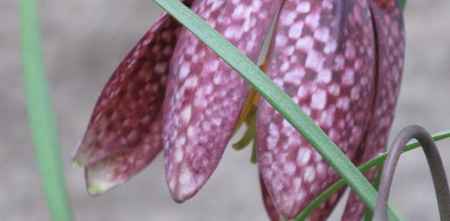
Guinea-hen flower (Fritillaria meleagris) blooming in Bonnefont garden; both the common name and the botanical name of this European flowering bulb refer to the fancied resemblance of the checkered bell to the plumage of the African guineafowl (Numidia meleagris). Photograph by Corey Eilhardt. See full image.
Of the facultie of these pleasant floures there is nothing set down in antient or later Writers, but [they] are greatly esteemed for the beautifying of our gardens, and the bosoms of the beautifull.
???”Of Turkie or Ginnie-Hen Floure” from The Herbal or Generall Historie of Plants
The English names of this curious flowering bulb were derived from the resemblance of its distinctive markings to those of the African guineafowl, imported into Europe from Turkey. John Gerard’s remarks clearly indicate that he knew the plant only as a rare and choice ornamental introduced into English flower gardens, including his own. He considered their native country to be France, where he knew them to grow wild near Orleans and Lyons. Read more »
Tags: African guineafowl, alkaloid, Flos meleagris, Fritillaria, Fritillaria meleagris, fritillary, fritillus, Geoffrey Grigson, Guinea-hen flower, John Gerard, Numidia meleagris, Rembert Dodoens
Posted in Gardening at The Cloisters | Comments (2)
Wednesday, June 23, 2010
Above, from left to right: Herb paris (Paris quadrifolia) flourishing in the dappled shade of a quince tree in April (although typically four-leaved, five- and six-leaved forms of herb paris like these are not uncommon); a detail of the narrow-petaled, star-like green flower with golden stamens; detail of the single black fruit, ripening in late June. Photographs by Corey Eilhardt.
Herbe Paris riseth up with one small tender stalke two hands high; at the very top come forth foure leaves directly set one against another in the manner of a Burgundian Crosse or True-love knot: for which cause among the Antients it has been called Herbe True-love.
???John Gerard, the Grete Herbal, or Generall Historie of Plants
Trew-loue among men is that most is of lette,
In hates, in hodes, in porses, is sette.
Trewe-loue in herbers spryngeth in May.
Bot trew-loue of herte went is away.
???Popular Middle English rhyme.
The leaves of herb paris suggested both the the cross of Christ and the true-love knot to the medieval mind, and both these resemblances were exploited allegorically. The popular Middle English rhyme quoted above alludes to the custom of placing the spring-blooming herb paris in hats, hoods, or purses as a charm for luck in love, while stressing how quickly such love is lost. Read more »
Tags: arsenic, Fasciculus Morum, Geoffrey Grigson, Grieve, herb paris, Hortus Sanitatis, John Gerard, Juliet, medicine, mercury, pars, Pietro Mattioli, poison, quadrifolia, quatrefoil of love, Romeo, Susanna Greer Fein, true love, Venus
Posted in Magical Plants, Medicinal Plants | Comments (0)
Friday, June 4, 2010
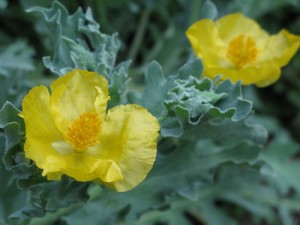
Horned poppy (Glaucium flavum) flowering in Bonnefont Garden in a sunny bed devoted to medicinal plants. Like other members of the poppy family, the horned poppy contains poisonous alkaloids.
The yellow horned poppy hath whitish leaves very much cut or jagged, somewhat like the leaves of garden Poppie, but rougher and more hairie. The stalks be long, round, and brittle. The floures be large and yellow, consisting of foure leaves; which being past, there come long huskes or cods, crooked like an horn or cornet, wherein is conteined small black seede. The roote is great, thicke, scalie, and rough, continuing long.
???John Gerard (1545???1612)
The Elizabethan herbalist John Gerard???s meticulous description of the plant which he names in Latin as Papaver cornutum flore luteo, “the horned poppy with the yellow flower,” was based on personal observation. He notes that it “groweth upon the sands and banks of the sea,” and lists the many places along the English coast where he found it growing. Read more »
Tags: alkaloid, Dioscorides, Eryngium maritimum, Geoffrey Grigson, Glaucium flavum, Hortus Sanitatis, John Gerard, poppy, sea holly, sea poppy
Posted in Medicinal Plants | Comments (1)



